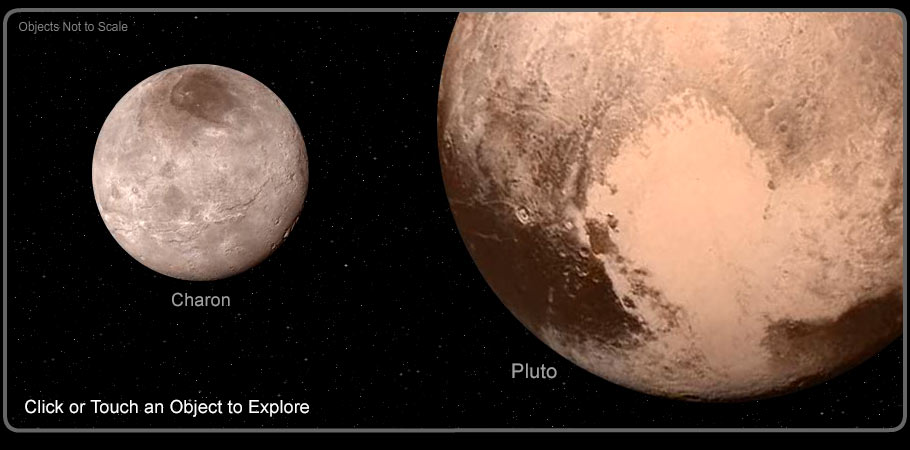A Double Dwarf Ice World
As we leave the Neptunian system behind, we eventually encounter a region of small, icy bodies. This is a section of the Solar System known as the Kuiper Belt. The Kuiper belt was named after Dutch-American astronomer Gerard Kuiper. It is a region filled with frozen objects composed of ices such as methane, ammonia and water. Over 100,000 objects have been discovered here. Most of the objects in the Kuiper Belt are small, but a few are nearly large enough to be planets. These objects are known as dwarf planets. The largest and most famous object in this region is Pluto. Formerly classified as a planet, Pluto was downgraded to a dwarf planet when astronomers discovered that there are likely to be dozens or even hundreds of Pluto-sized objects in the Kuiper Belt.
Pluto is orbited by five known moons. The largest of these is Charon. Charon is more than half as large as Pluto. It is so large in comparison to Pluto that many astronomers consider it to be a double dwarf planet. The two bodies actually orbit each other around a common center of gravity.
A Planet No More
Since its original discovery in 1930, Pluto was classified as the ninth planet in the Solar System. In fact, its has always been a favorite among school kids. Most of us can probably remember learning to name the order of the planets, which ended with Pluto. But in 2005, astronomers discovered a new object beyond the orbit of Pluto. This new object, known as Eris, which was found to be substantially more massive than Pluto. Over the next few years, several more large objects were also discovered in the same region. Astronomers believe there could be hundreds of these icy worlds lurking beyond the orbit of Neptune.
Rather than add hundreds of new planets to the Solar System, The International Astronomical Union (IAU) voted in 2006 to change the definition of a planet. The new definition specified that the object must be large enough to clear its orbit of other objects and debris. Planet-like objects that do not satisfy this condition were classified as dwarf planets. Thus, with the single stroke of a pen, Pluto was stripped of its status as a planet. It was a dark day for Pluto fans. But the alternative would be for school kids of the future to memorize hundreds of new planets.
Exploring the Plutonian System
All though Pluto was discovered in 1930, not much was known about it until recently. Up until 2015, the best view of Pluto was captured by the Hubble space telescope. It shows Pluto and Charon showed as two tiny star-like dots. In 2005, two tiny satellites were discovered and named Nix and Hydra. Kerberos was the next discovery in 2011 and Styx was found in 2012. In July of 2015, NASA's New Horizons spacecraft arrived in the Plutonian system. The spacecraft was traveling too fast to stop, so it only had a brief flyby to gather data. But we finally got our first close-up view of this mysterious world. Scientists were baffled by the images, and many new discoveries were made.
Pluto's surface was found to be much more varied and dynamic that anyone had imagined. Flat plains and ice mountains were discovered. The planet's surface was found to be mostly free of craters while Pluto's moon, Charon, was found to be covered in craters. Pluto itself was found to be slightly larger than previously. And it was discovered to have a thin, nitrogen-rich atmosphere that extends out as far as 1,000 miles (1,600 kilometers) from the surface.
There are currently no definite plans to send another mission to Pluto. But since the New Horizons mission seems to have found more questions than answers, there are many in the scientific community that would like to see a new mission to send a probe to orbit the dwarf planet. Even if this mission is eventually developed, it will probably take ten or more years to reach the Plutonian system.




